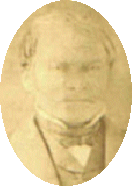
 |
George Backart, farmer and miller, residing in Croton, was born in Schupheim, Baden, Germany, Aug. 19, 1808. His parents, Michael and Fronia (Miller) Backart, were both natives of the same place; the former was born in 1781 and died in 1853; the birth of the latter occurred in 1784, and her death in 1856, in Germany.
Mr. Backart was a resident with his father in the land of his nativity until he was 16 years of age. He received the compulsory education regulated by the law of Germany, and attended school from the age of six to fourteen years. When he was 16 years old he was apprenticed, in conformity with the custom of the country, to learn the trade of blacksmith, and consumed two years n acquiring the details of the business. Three ears following the expiration of his indentures he worked in various places; at the age of 22 years he established himself independently in his own shop. He operated until 1834, when he disposed of his business, came to the United States, and settled in Oneida Co., N. Y. He bought 40 acres of land, where he carried on farming seven years. He sold out in 1841 and went to Dupage Co., Ill, where he again engaged in farming, becoming proprietor by purchase of 60 acres of land. In addition to his agricultural labors he managed a sawmill on Dupage River, owned by another man. He was thus engaged 10 years. In 1850 he sold his property in Illinois and settled in Croton, Nov. 4, that year. The place was then known as "Muskegon Fork" and Mr. Backart was accompanied by Warren Smith and Alpheus Fowler. The two latter had purchased a saw-mill of John F. Stearns, which they proposed to operate. It was built about 10 years previous, and was the first mill erected in this section. The purchase included 300 acres of land. Mr. Backart came for the express purpose of managing the mill, but declined to invest his means in the property until the second year, when he purchased a third interest. The saw-mill was in complete running order. Smith & Fellows sold out in the course of a few years to other parties, but Mr. Backart continued to hold his proprietorship. He finally disposed of his interest in the mill, but has continued to hold his land claim. He reserved his right to the water-power, and in 1857 built a saw-mill, which in 1861 was remodeled into a grist-mill, which he has since conducted as such. He has purchased and now owns another mill in the immediate vicinity. He owns two houses in Croton village, one of which he occupies. He also owns 250 acres of land in the vicinity of Croton village.
Mr. Backart was one of the first permanent settlers where Croton village now stands. Himself, Warren Smith and John A. Mills were the parties instrumental in the platting of Croton, and in having the same recorded. The survey was made by John Alma, in November, 1854. Jefferson Morrison and Robert P. Mitchell were also interested in the founding of the village, which was incorporated in 1869. Mr. Backart is a Democrat in political principle and action, and has been closely connected with municipal affairs in his township. He officiated ten years as Supervisor, and six years as Treasurer, and has held other offices of less importance. He was appointed Postmaster under President Fillmore, and again under President Buchanan.
Mr. Backart was married in his native place, April 19, 1830, to Mary Adeline Backart, who was born in the same place, Sept. 7, 1810, and is the daughter of Sebastian and Annie Magdalena (Schneider) Backart. Her parents were both born in Schupheim, Germany, the father in 1779, and the mother in 1791. Sebastian Backart was a soldier of the allied forces in the wars of Napoleon Bonaparte, and just previous to the battle of Waterloo contracted camp typhoid fever. He recovered, but his wife took the disease and died in 1814. The husband survived until 1848. To Mr. and Mrs. Backart eight children have been born, namely: Mary Magdalena (dec.), Mary Elizabeth, George (dec.), Charles F. (dec.), Mary Eliza, Julius S., Mary Jane and Alice Evaline. The family are Lutherans.
 Return to Home Page
Return to Home Page Return to Pioneers
Return to Pioneers
© 1997-2001 by Monica Erickson. 2002-2009 by Jan Cortez. All rights reserved.

